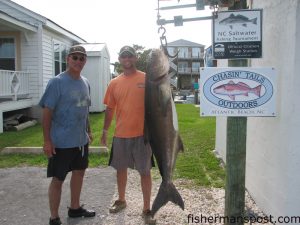Swansboro June 4, 2009

Jacob Wescole and his father, from Willow Springs, NC, with an 88 lb. cobia that fell for a dead pogy fished on the bottom of Beaufort Inlet. Weighed at Chasin Tails Outdoors.
Jeff, of FishN4Life Charters, reports that spanish mackerel are thick off Bear and Bogue Inlets. Most are 1-3 lbs., with a few in the 4-6 lb. class feeding over the AR’s and nearshore live bottom areas.
Small gold and silver Clarkspoons pulled behind planers and trolling weights will produce plenty of action with the spanish, but the larger fish prefer a live bait like a finger mullet, pogy, cigar minnow, or threadfin. Slow trolling the live baits on light wire leaders will produce action with the larger fish around the nearshore structure.
Summer flounder are feeding in the same areas as the big spanish, and anglers can find action with them while drifting Carolina-rigged live baits or bouncing Gulp-tipped bucktails off the bottom.
A bottom rig baited with squid, frozen shrimp, or conch strips will produce sea bass, triggerfish, and tautog around the same structure.
Inshore, there are plenty of red drum feeding in the backwaters, and they’re scattered throughout the bays and creeks. They’ve been very willing to strike topwater plugs in the early mornings, late afternoons, and at the highest tides. On lower tides, anglers can hook up on spinnerbaits or jigheads with Gulps while casting near shell bottom channel walls.
The channels near the inlets are starting to produce action with flounder (most 14-20″), and anglers are also hooking flatties in the ICW outside creek mouths on the falling tides. Sheepshead have been feeding around the area’s dock and bridge pilings. Live fiddler crabs or mud crabs will get attention from the sheepshead.

Nancy Evens, of Morehead City, with a 9 lb. bluefish that fell for cut bait on light spinning tackle. She was fishing from the Sheraton Pier at Atlantic Beach.
Rob, of Sandbar Safari Charters, reports that offshore anglers have found solid dolphin fishing lately, with a few wahoo thrown in.
Over the next few weeks, the dolphin will move even closer to shore, and anglers will get shots at the fish at spots in the 10-12 mile range like the Charlie Buoy.
Closer to the beaches, the warming water is pushing king mackerel from the offshore waters to the wrecks, rocks, and live bottoms in the 5-10 mile range.
There are still plenty of bluefish and spanish mackerel feeding along the beaches, and anglers can either troll or cast to hook up with them.
Flounder (up to 20+”) are making an appearance on the nearshore structure as well as inshore, where anglers are hooking them in the marshes, creeks, bays, and around deeper inshore structure. Drifting with live tiger-side minnows or other live baits will draw strikes from the flatfish, and anglers are also finding action with 4″ Gulp shrimp, especially in New Penny.
Smaller shrimp are holding in the backs of the creeks, and anglers are pinning them to float rigs to hook speckled trout in the deeper holes of the creeks.
Live shrimp fished under a popping cork are also extremely effective for the red and black drum feeding around oyster rocks in the marshes. Black drum in particular are holding on just about every oyster rock off of a grass point in the barrier island marshes.
Sheepshead are beginning to feed beneath the area’s bridges and at other hard structure, where a fiddler or mud crab dangled next to the pilings will attract their attention.
Chesson, of CXC Fishing, reports that the dolphin bite has slowed a bit from last week’s hectic pace, but boats are still hooking up with good numbers of dolphin in the Gulf Stream and inshore of it. Kite fishing with an artificial flying fish is one of the most exciting ways to hook up with the ‘phins.
Amberjacks are schooling up on most any high-relief structure offshore, and anglers can tempt them to bite with live baits, jigs, or topwater poppers when they’re feeding high in the water column.
Dale, of The Reel Outdoors, reports that the dolphin bite has still been excellent between the 90’ Drop and the Big Rock. Trolling ballyhoo under skirted lures is the best way to hook up with the dolphin.
Closer to the beaches, boaters and pier anglers are seeing a few cobia, but many are 1-2 inches short of the 33″ minimum size.
Surf anglers are hooking up with some spanish mackerel and bluefish on gold and silver spoons, and pier anglers are getting in on the action with Gotcha plugs.
Whiting, black drum, and pompano are all feeding along the bottom in the surf zone, and bottom rigs baited with shrimp or sand fleas will attract their attention.
Inshore, the red drum bite is improving, and anglers are hooking them in the marshes on topwater plugs, spinnerbaits, and Gulps.
Rhonda, of Bogue Inlet Pier, reports that plug casters are finding plenty of action with spanish mackerel and bluefish.
Bottom fishermen are hooking a mixed bag of whiting, black drum, and pompano, mostly on shrimp.
